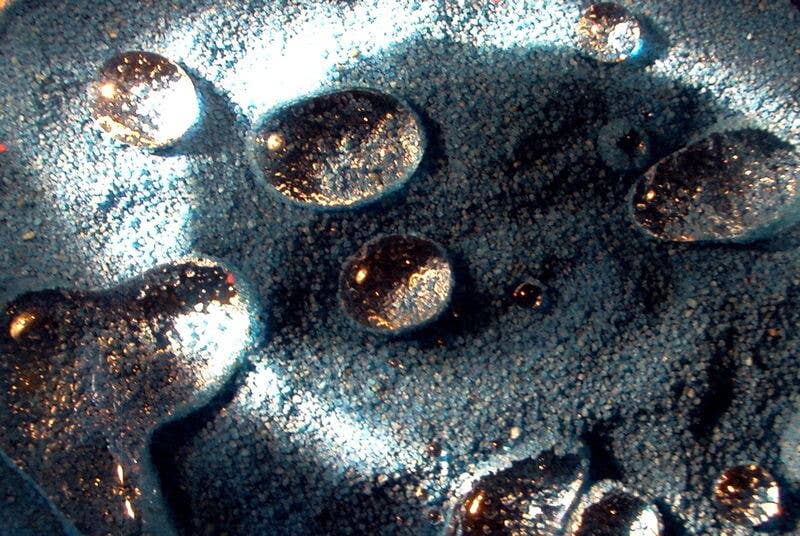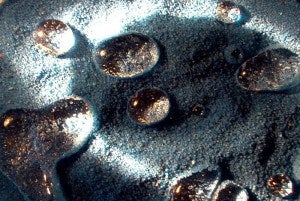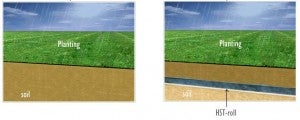Waterproof Nanotech Sand Could Change Deserts into Farms

Share

Nano-thick coatings allow sand to repel water.
Nanotechnology may conjure up images of tiny robots, or machines in our blood stream, but what about really cool dirt? DIME, a company based in the United Arab Emirates, has licensed a nanotech process to create hydrophobic sand. The extremely thin coating on each grain causes it to repel water. While similar technologies have existed for several years (see the video for 'Magic Sand' below), DIME sells a plastic wrapped hydrophobic sand that can be used to create an artificial water table. This high tech sand bag, called a HST-roll, could change the nature of farming in the Middle East. With a production of more than 3 thousand tonnes a day, DIME is on the path to help the desert bloom.
Water scarcity is an enormous problem around the world. While potable water gets all the press, irrigation is where much of the consumption happens (up to 85% in the Middle East). Regions with sandy soil leach water away as it is being used, and salt rises to the top. That's a lethal combination for crops. DIME's HST-rolls work by forming a giant water-proof layer under the topsoil. You lay them out like a pool liner. When crops are grown in the soil above, less water is needed because it isn't sucked deep underground. It also prevents salt from flowing into the topsoil. Water use could be cut by as much as 35% (granted these numbers are from DIME itself).
DIME's hydrophobic sand production is licensed from a German firm and they aren't very forthcoming on the exact process, obliquely referring to the additive used as SP-HFS 1609. Some sort of nanometer thick coating is applied to each and every grain of sand. Similar products, like the one shown in the video above, use a silica layer. No matter the exact mechanism involved, the results are the same: the coated sand will repel water or move through it to minimize water contact. Hence the snake-like shapes that form as the sand is poured into a glass.
Part of the appeal of hydrophobic substances is that they are so versatile. Original designs called for them to be used as solutions to oil spills. Grains of the sand would float on the water until bonding to oil. At that point the sand would clump together and become dense enough to sink, eliminating most of the hazard of the floating crude. Hydrophobic sand can also be used under concrete foundations to stop water-caused settling or seepage. HST-rolls could help solve erosion concerns along beaches.

Typical land use on the left allows water to flow quickly away. With the use of hydrophobic sand bags, right, an artificical water table increases efficiency.
Be Part of the Future
Sign up to receive top stories about groundbreaking technologies and visionary thinkers from SingularityHub.


Yet it's the water retention promises that make hydrophobic sand so important. The UAE, one of the wealthiest countries per capita in the Middle East, is a great testing ground for desert reclamation. While it imports major staples (rice, grains, etc) it also has a history of seeking of agricultural independence in recent years. If the Emirates can increase the water efficiency of their arable land they may secure themselves against future instability as petroleum prices continue to fluctuate.
Of course I'm no expert in water drainage management, but wouldn't a plastic tarp work just as well as magic sand? That would seem like a much cheaper option. I can't find an answer to that question anywhere, so I'm going to assume that I'm being obtuse somehow. I have to hope that the UAE would have at least investigated the 'tarp-option' before spending millions on hydrophobic sand.
We future-looking bloggers have a tendency to focus on the most awe-inspiring uses of technology, but it's the way nanotech changes food, shelter, and water that will really alter our world. Sand that can pick up oil, or stay dry while you play with in the pool is cool, but sand that can help you feed your family? That's powerful. And it's proof that while technology can't solve every problem, it's certainly going to try.
[Image Credit: Steve Jurvetson and DIME website]
Related Articles

Single Injection Transforms the Immune System Into a Cancer-Killing Machine

This Light-Powered AI Chip Is 100x Faster Than a Top Nvidia GPU

This Week’s Awesome Tech Stories From Around the Web (Through December 20)
What we’re reading